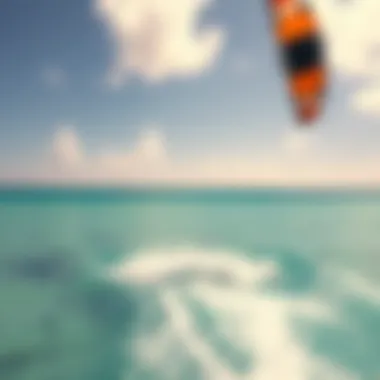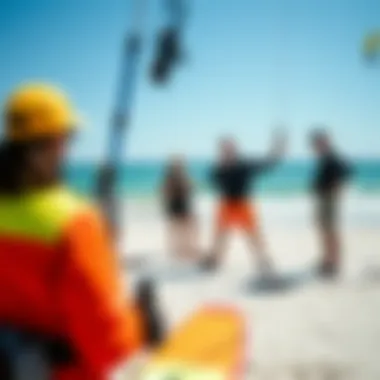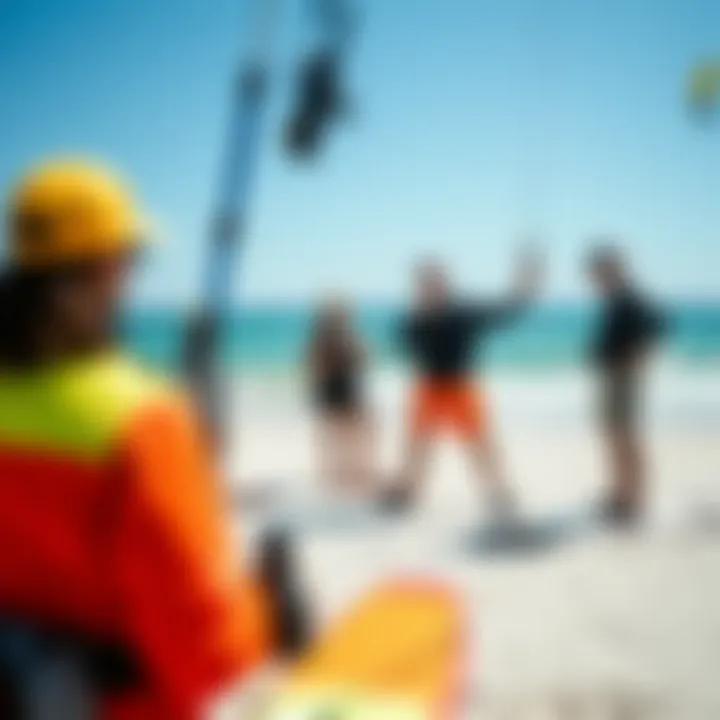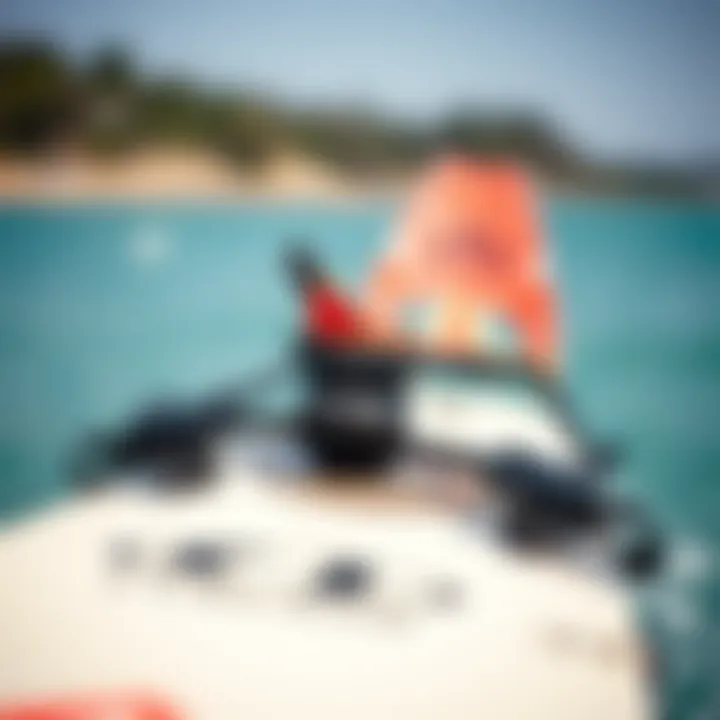Kiteboard Lessons: Your Guide to Mastering the Sport


Intro
Kiteboarding sits at the thrilling intersection of surfing, football, and paragliding. It’s not just about flying high on the water but also mastering the elements around you. For those eyeing the horizon, eager to carve through waves or catch air, proper kiteboard lessons can make all the difference. Whether you're a complete novice or someone looking to refine your techniques, the right instruction is key to not only enjoying the sport but also ensuring your safety.
Kiteboard lessons offer an extensive framework for learning, ranging from basic maneuvers to advanced tricks. This guide aims to demystify the process, covering various facets that new and seasoned kiteboarders must consider. From selecting the right gear and instructors to understanding the importance of different environments, we’ll delve into every nook and cranny of what makes kiteboarding both exhilarating and safe.
Now, let’s take a closer look at the gear you’ll need to hit the waves.
Understanding Kiteboarding
Understanding kiteboarding goes beyond merely grasping its terminologies; it's about recognizing the beautiful dance between a person, a kite, and the wind. For those drawn to this captivating sport, an initial comprehension lays the groundwork for mastery and appreciation of kiteboarding's intricacies.
The Basics of Kiteboarding
At its core, kiteboarding blends elements of surfing and paragliding, relying on wind power to propel the rider over water. An individual uses a traction kite to harness this power, allowing them to glide, jump, and perform various tricks. Here's a simplified breakdown:
- Kite: This is the heart of the sport, varying in size and shape to suit different wind conditions and rider skill levels. Beginners usually start with a smaller kite, as it’s easier to control.
- Board: Riders stand on a board similar to a surfboard. The size and type of board can affect performance and comfort in the water.
- Safety Gear: Helmets, life vests, and harnesses come into play to ensure the rider remains safe while minimizing the risk involved.
Learning these basics is crucial, not only for safety but also to enhance the overall experience on the water. Drift a bit further into kiteboarding, and one finds the thrill of catches with the wind, the adrenaline rush during jumps, and, most importantly, the sense of community among those who share the passion.
The Evolution of Kiteboarding
Kiteboarding's journey began in the late 1960s but didn’t gain popularity until the late 1990s. Originally, enthusiasts designed their own makeshift equipment, using para-sails and surfboards. Fast forward to today, and we see a full-fledged industry catering to this exciting sport. Modern kites are meticulously engineered, giving riders enhanced control and stability - a far cry from those initial creations.
"It is fascinating to see how kiteboarding has transformed from a niche hobby into a globally celebrated sport with competitions, professional athletes, and dedicated enthusiasts across continents."
Over the years, advancements in technology have improved materials and designs, enabling tricks that were once unimaginable. Kiteboards have evolved to be lighter, allowing for faster maneuvers, while kites now feature advanced control systems, making them more user-friendly. Every fresh generation of kiteboarders stands on the shoulders of predecessors, learning from their trials.
This evolution makes understanding kiteboarding an intriguing endeavor, as practitioners bear witness to the sport's rich history. Knowing where kiteboarding began adds depth to the experience - it’s about appreciating how innovators and daredevils shaped the sport into what it is today.
Importance of Professional Lessons
Kiteboarding is not just a sport; it's an art form that intertwines skill, technique, and safety. Deciding to take professional lessons adds a significant layer of depth to this exhilarating experience. The importance of engaging with certified instructors transcends mere technical know-how. It embraces a holistic approach that considers the mental, emotional, and physical aspects of kiteboarding. Everything from learning to navigate the wind to understanding how to react to unexpected situations can be better managed under the guidance of an expert.
Benefits of Professional Instruction
Professional kiteboarding instruction brings numerous advantages, making the investment well worth it. Here are some key benefits:
- Structured Learning: Professional lessons provide a well-defined curriculum that covers essential aspects of kiteboarding—from the fundamentals to advanced techniques. This structure ensures that nothing vital is missed.
- Safety First: Instructors prioritize safety and teach students about potential hazards. The right instructor will ensure you’re well-versed in safety protocols which is crucial to enjoy the sport without unnecessary risks.
- Adaptive Techniques: Experienced teachers know how to tailor lessons according to individual needs and learning speeds. They can adapt their methods based on your progress, thus maximizing your efficiency in learning.
- Confidence Building: Professional instructors often create a supportive environment that fosters confidence. By receiving encouragement and positive feedback, students often feel more at ease and willing to push their limits.
- Access to Equipment: Many kiteboarding schools provide high-quality gear as part of the lessons. This allows students to experience different types of equipment without having to make immediate purchased decisions, giving them time to figure out their preferences.
Professional instructors also help you avoid many common pitfalls that beginners encounter. A seasoned kiteboarder can show you the ropes of kite control, water positioning, and even the art of riding upwind, making your learning curve much smoother. Your time spent learning with a pro could potentially save months of trial and error on your part.
Identifying Quality Instructors
Finding the right instructor can be a daunting task, especially with so many options available. However, certain characteristics can help to identify top-notch professionals. Look out for the following:
- Certifications and Affiliations: A good instructor will have relevant certifications from reputable kiteboarding organizations, like the International Kiteboarding Organization (IKO) or the Professional Air Sports Association (PASA). These credentials often signify that the instructor has received formal training and ongoing education.
- Experience: Assessing a potential instructor's experience is crucial. Instructors with several years under their belts will likely have encountered various situations and will be better equipped to guide students through challenges.
- Teaching Style: Everyone learns differently; thus, it is beneficial to have a teacher whose style resonates with you. Some instructors may be more hands-on, while others take a more laid-back approach. It might be worth scheduling a trial lesson to gauge compatibility.
- Reviews and Recommendations: Online reviews can offer valuable insight into an instructor's effectiveness. Websites like reddit.com and community forums can also provide personal experiences from fellow kiteboarders.
- Passion and Enthusiasm: An instructor's passion for the sport can greatly influence your learning experience. Look for someone who genuinely enjoys teaching and asking questions, rather than just going through the motions.
Engaging in professional lessons lays the foundation for a fulfilling kiteboarding experience. Combining structured education with skilled instructors not only promotes safety but also encourages personal growth in this dynamic sport. This thoughtful approach to learning can lead to more challenging adventures and ultimately, a deeper connection with kiteboarding.
Lesson Structure and Curriculum
When diving into kiteboarding, understanding the structure and curriculum of lessons is as vital as choosing the right equipment. A well-organized lesson structure ensures that students not only learn the essentials but also build confidence as they progress. It lays a solid foundation for mastering the sport, enables instructors to gauge their students' development, and fosters an environment conducive to learning.
Typical Lesson Components
Safety Briefing
A safety briefing is the backbone of any kiteboarding lesson. It serves to inform students about the potential risks they face and how to navigate these challenges effectively. This aspect of the lesson is pivotal for ensuring participants feel secure before they hit the water. An important characteristic of a safety briefing is its systematic approach that covers everything from proper kite handling to emergency signaling.
The unique feature of these briefings is that they often incorporate real-life scenarios or experiences shared by instructors. This method not only engages the students but also helps them understand the seriousness of safety protocols. It's a well-structured practice that can prevent accidents and equip learners with the necessary skills to react swiftly.
“In kiteboarding, the wind might take you places, but safety keeps you grounded.”
Equipment Setup
Another crucial aspect of kiteboarding lessons is the equipment setup. Knowing how to properly set up a kite, ensure the safety lines are clear, and check each component is vital for a successful session on the water. This part of the lesson highlights the importance of being methodical and attentive to detail. Identifying key features such as the bar and lines, along with understanding how each element works together, is essential.
What makes equipment setup particularly beneficial is that it fosters independence among learners. As students become knowledgeable about equipment, they gain confidence, allowing them to prepare for sessions without constant guidance from an instructor. However, it can be overwhelming for some beginners if not paced appropriately, leading to possible frustration.
Water Skills
Water skills are where the sense of freedom in kiteboarding truly begins. This aspect focuses on harnessing wind power and translating it into movement across the water. Practicing water starts, body dragging, and navigating through currents is fundamental when progressing in kiteboarding. The key characteristic of water skills is that they are hands-on and directly applicable; students experience the thrill of kiteboarding firsthand.
A distinctive feature of this component is that it combines both physical and mental challenges. Learners must not only execute techniques but also read the water and wind conditions. While this leads to exciting achievements, it may also dishearten those who struggle at a pace. Continuous support from instructors can mitigate those feelings, assuring learners that mastery comes with practice.
Progression Paths in Kiteboarding


Progression paths in kiteboarding illustrate how students can evolve from novice to advanced riders. Understanding these pathways allows students to set realistic goals and milestones. Beginners often start with fundamental skills such as handling the kite and learning to steer. As their confidence grows, they move onto advanced techniques like jumping and tricks. A structured progression path not only helps maintain motivation but also ensures comprehensive skill development, paving the way for a rewarding kiteboarding journey.
Learning Environments
When it comes to kiteboarding, the environment in which you learn can be as critical as the skills you are trying to master. Learning environments vary widely, each offering unique characteristics that cater to different skill levels, preferences, and local conditions. The ideal setting can significantly affect the comfort levels and learning pace of novices and pros alike. Selecting the most suitable location will enhance your experience and ensure that you make the most of each lesson.
Choosing the Right Location for Lessons
Choosing the right spot to learn kiteboarding is like picking the right pair of shoes for a long hike. The location sets the stage, and each has its own quirks and perks.
Beaches vs. Lakes
When weighing the options between beaches and lakes, there are distinct advantages to both. Beaches offer expansive space and trendy vibe, making them a favored spot for many kiteboarders. The open ocean generally means more consistent wind, which is absolutely vital for beginners who are just getting their feet wet. On the other hand, lakes can provide a more controlled environment, where the water is generally flatter and the wind tends to be less gusty. This can help new kiteboarders focus more on learning the sport rather than battling with tricky conditions.
Beaches might, however, be swarmed with tourists and locals alike, making them feel crowded at times. In contrast, lakes might have limited space, and not all lakes permit kiteboarding activities, so it's essential to check local regulations.
Wind Conditions
Wind conditions are like the lifeblood of kiteboarding. They dictate what’s possible and what’s prudent on any given day. Ideal learning conditions usually involve steady winds that aren't too harsh, normally between 12 to 20 knots.
Beaches often provide ideal wind conditions thanks to the openness of outdoor spaces. However, landscapes can cause wind shadows, where gusts are unpredictable. While this can be exhilarating for seasoned riders, it can be a headache for novices still mastering the basics. Conversely, lakes generally have calmer, more moderate wind conditions, which facilitate learning without the rollercoaster of unpredictable gusts and lulls.
Each location's wind characteristics can profoundly impact the overall learning experience, making it vital for students to choose wisely.
Water Depth
Water depth is another element to examine when selecting a learning environment. Shallow waters make it easier to get back on your board after falling, which happens, and is often part of the learning curve. It allows learners to practice safely without the fear of deep-water swims.
Suitably shallow beach areas might exist, but finding safe zones can be tricky. Lakes typically offer wider expanse of shallow areas, making them safer for beginners. Learners can focus more on their tricks rather than worrying about sudden drops below the surface. Yet one must stay vigilant about potential depths at various locations where the wind might influence how far out one should go.
Adapting to Various Conditions
In the world of kiteboarding, conditions can change in the blink of an eye. Whether you're dealing with sudden gusts of wind or varying water depths, flexibility is crucial. Adapting to different conditions is integral to growing as a kiteboarder. Being prepared and willing to adjust your techniques will not only keep you safe but also improve your skills overall. Practice patience and resilience; learning how to navigate changing conditions can be as valuable as mastering advanced tricks.
Make sure to familiarize yourself with weather forecasts, tide tables, and local advisories. Being in tune with your surroundings not only bolsters your skills but also enhances the overall kiteboarding experience.
Safety Protocols
When it comes to kiteboarding, safety is far from just a checkbox on a list; it’s the golden rule. Engaging in this exhilarating sport without the right precautions is like diving into a pool without checking the water first—you're asking for trouble. The waves and winds can be unpredictable, and being well-prepared can be the difference between a fun day out and a potential catastrophe. That's why understanding safety protocols is crucial for both enthusiasts and instructors alike.
Essential Safety Gear
Harnesses
Harnesses are an integral piece of kiteboarding gear. They provide a secure connection between the rider and the kite, distributing the pull evenly across the body. This lady of the gear realm often comes in two style varieties: seat and waist harnesses. The seat harness sits lower on the hips and is often preferred by beginners as it offers more support and stability. Waist harnesses, on the other hand, allow more freedom of movement and are often favored by more experienced riders.
Key Characteristic: One of the standout features of a good harness is its padding. This unique aspect makes a world of difference during your ride, reducing the risk of chafing. A padded harness helps riders stay comfortable even during extended periods on the water, which is an invaluable benefit.
However, a harness isn't one-size-fits-all. It's key to try them out before committing. Some harnesses might slip or dig in uncomfortably, which can lead to an awkward experience on the water, emphasizing the need for proper fit and adjustability.
Helmets
Helmets in kiteboarding serve a purpose that's all too evident. They protect one of your most valuable assets— your head. Falling from the sky, or even a close encounter with rough water or hard objects can lead to serious injuries. A helmet mitigates the risk significantly.
Key Characteristic: Most kiteboarding helmets come with a flotation feature. This unique element is a lifesaver, literally, as it can keep you above water if you fall. Whether zipping across waves or performing tricks and landing hard, this added protection means your noggin is shielded, anxiety-free.
Advantages: Comfort is also a feature—many helmets are designed to fit snugly but not overly tight, ensuring that you’re both safe and at ease. However, they can get warm, especially under direct sunlight, so look for models with ventilation if you're planning to ride for hours on end.
Wetsuits
Wetsuits, while may appear as simple attire, their role in kiteboarding is profound. They keep the body insulated during chilly water rides and protect against sun exposure. A high-quality wetsuit allows you to stay out longer, enhancing your experience significantly.
Key Characteristic: The thickness of a wetsuit is critical for temperature control—generally ranging from 2mm to 6mm. Choosing the right thickness can be tricky, as too thick can restrict movement while too thin leaves you shivering cold.
Advantages and Disadvantages: A notable advantage of wetsuits is their flexibility due to neoprene, which allows for a wide range of motion essential for dynamic kiteboarding maneuvers. However, lighter wetsuits may not provide as much warmth, so it's essential to balance flexibility and insulation based on your home waters.
Emergency Procedures
Even the most caution-oriented kiteboarders can find themselves in a sticky situation. Knowing what to do in an emergency is as vital as any piece of gear. It’s good to have a solid grasp of basic emergency procedures.
- Signal for Help: Ensure you're well-versed in hand signals to communicate effectively with other riders or potential rescuers. A raised arm can mean you need help, while waving could signal distress.
- Emergency Release Systems: Familiarize yourself with the quick-release mechanism on your harness and kite. Knowing how to use it could save your life if a gust takes your kite off course.
- Buddy System: Always try to ride with a friend. Not only does it double the fun, but having a reliable partner can be crucial in case of emergencies.
In this sport, it’s better to be overly cautious than too relaxed. Kiteboarding can be exhilarating, but your safety is always paramount. Taking these precautions will ensure that you get to enjoy that adrenaline rush time and time again—while staying safe.
“Kiteboarding is like poetry in motion—unless you're not paying attention.”
For further guidance on safety practices, you can visit U.S. Coast Guard, American Kiteboarding Association, and discuss experiences on forums like Reddit.
Equipment Insights


When diving into the world of kiteboarding, understanding the equipment is pivotal. The right gear can make the difference between a memorable day on the water and a frustrating experience. Generally speaking, kiteboarding equipment consists primarily of the kite and the board, but the nuances of these items are what truly shape a rider’s performance and enjoyment.
In this section, we will explore the essential gear for beginners and seasoned riders alike, offering insights that will aid you in making informed decisions. Being equipped with the right tools can enhance safety, improve skill development, and ultimately lead to a more fulfilling kiteboarding journey.
Kite Selection for Beginners
Selecting the right kite is vital for those just beginning their kiteboarding adventure. Beginner kites are designed with specific characteristics that cater to new riders. They tend to be larger and more stable, allowing novices to learn how to harness the wind without feeling overwhelmed. Generally, a larger kite captures more wind; thus, it provides better lift.
A good option for beginners often combines a simple design with reliable performance. Features to consider include a steady pull and predictable behavior in the air. This predictability means when the kite is in the air, it should fly consistently and respond well to steering adjustments. Many beginners underestimate this factor, but having a kite that behaves well in various conditions can build confidence.
Understanding Boards
Understanding the difference between various boards is equally important in the kiteboarding experience. Boards are categorized primarily by their intended use, which ranges from freestyle to surf styles. Understanding these categories can help you choose the appropriate board based on your interests and environment.
Different Board Types
The different types of kiteboarding boards present unique characteristics that cater to specific riding styles.
- Twin Tip Boards: These are the most common and are versatile for flat water and choppy waves. They feature identical nose and tail shapes, allowing riders to ride in both directions, which is great for beginners.
- Directional Boards: Unlike twin tips, directional boards are meant primarily for riding one way, mimicking surfboards. They excel in waves, but can be more challenging for beginners who are still getting accustomed to kiteboarding.
- Foil Boards: These boards come equipped with a foil that lifts the rider above the water's surface. They offer a different riding experience and enable smoother rides over chop. They might intimidate beginners due to their unique handling.
Choosing a board that fits your riding style and skill level can make the learning curve more manageable. Each type has its pros and cons, so it’s worth exploring them before making a choice.
Choosing the Right Size
When it comes to selecting the right size of board, it’s crucial to consider your weight, skill level, and the kind of riding you intend to do. Generally, larger boards provide more surface area and better stability, especially for beginners who may struggle with balance. They're also beneficial in light wind conditions as they help riders catch more air and maintain momentum.
Conversely, smaller boards offer more maneuverability, catering to those progressing in their skills. They can provide a more exhilarating ride, allowing for sharp turns and tricks, but may pose a challenge without adequate experience.
Key Considerations:
- Weight and Height: A rider’s weight can determine the right size, as heavier individuals may need a larger board for stability.
- Skill Level: Beginners may lean towards larger boards, while more advanced riders can experiment with smaller sizes for agility.
Ultimately, taking the time to understand board dynamics not only aids in your initial learning but also fosters growth and development in your kiteboarding pursuits. Choosing the right hardware sets the stage for a thrilling and rewarding experience on the water.
Tricks and Techniques
Understanding the tricks and techniques in kiteboarding is essential for anyone serious about mastering the sport. These skills not only enhance your capability to navigate the water but also add an element of creativity to your riding. Learning different tricks allows you to express individuality while boosting your confidence on the board. Moreover, as you delve deeper into these maneuvers, you gradually become more acquainted with your kite’s handling, improving your overall performance.
Kiteboarding is filled with possibilities, and every newly learned trick opens doors to others, creating a progression that keeps the experience fresh and exhilarating. In this section, we will embark on an exploration of both fundamental tricks for newcomers and techniques that lead to more advanced maneuvers.
Fundamental Tricks for Newbies
For those starting their journey, it’s vital to focus on foundational tricks that build the right skills. Simple tricks such as the "pop"—that is, the act of getting airborne by using the tension in the lines—are great first steps. The pop sets the stage for more complex tricks in the future.
Other beginner-friendly tricks include:
- Basic Jumps: Learning to jump is often the first thrill a kiteboarder experiences. Not only does it give a rush of adrenaline, but it also lays the groundwork for more intricate tricks.
- Toe-side Riding: This involves riding with the board angled towards the toes instead of the heels. Mastering this helps improve balance and overall control on the board.
- Surface Tricks: Beginning with tricks like the "slide" where you glide sideways across the water can cultivate a sense of freedom and heightens confidence.
These initial tricks are not just simple maneuvers; they are building blocks that foster a sense of achievement and prepare riders for the more challenging techniques that lie ahead.
Progressing to Advanced Maneuvers
As you gain confidence and skill, you become ready to tackle more advanced techniques. This transition is significant as it marks the moment when kiteboarding evolves from mere riding to an expression of artistry in movement.
Jumping Techniques
Jumping is one of the most exhilarating experiences in kiteboarding. The beauty of jumping lies in the air-time and the possibility of combining various movements during the flight. A typical jumping technique includes bending your knees while pulling on the bar, which creates upward force.
The appeal of jumping techniques is not just about height but also about styling your jumps. A well-executed jump can showcase your capabilities and attract admiration from fellow kiteboarders. The unique feature about these jumps is that they can vary greatly—whether you are going for an aerial rotation or a straightforward buoyant leap. However, jumping does come with its hurdles; the landing component is crucial. Improper landings can lead to injury or equipment damage, so typically instructors emphasize a gradual approach to mastering jumps.
Spins and Rotations
Spins and rotations add flair to your kiteboarding repertoire. These maneuvers involve turning your body while in the air, combining elements of acrobatics with technical precision. The essential aspect of spins is control; kitesurfing presents the challenge of constraint, needing the rider to execute the turn gracefully without losing balance.
Practicing spins helps in developing a keen sense of timing and body position, both of which are critical as you progress. A distinctive quality of spins is that they can be adapted—from simple 180-degree turns to complex 720s—that gradually push the limits of what's possible on the board. In contrast, the downside lies in their complexity. They often require a steep learning curve, and one miscalculation can lead to a fall. Nevertheless, the rewarding nature of nailing a spin cannot be understated, making it a sought-after trick among experienced riders.
In essence, exploring tricks and techniques in kiteboarding serves as both a thrilling adventure and a deepening engagement with the sport. The transition from beginners’ moves to advanced features illustrates not just a growth in skills but also a deeper appreciation for the art of riding. Embrace this phase, practice diligently, and soon you'll find yourself soaring through the air, flipping and spinning, and truly mastering the ropes—or rather, the lines.
Community and Resources
Community and resources form the backbone of any sport, kiteboarding included. Engaging with fellow enthusiasts not only fosters a sense of belonging but also enhances the learning process. When individuals immerse themselves in local kiteboarding groups or online platforms, they unlock invaluable access to collective knowledge, mentorship, and encouragement.
Kiteboarding can be a thrilling adventure, but like most extreme sports, it demands both skill and caution. Therefore, having a supportive community around helps individuals share tips, organize practice sessions, and exchange experiences, making the learning curve less daunting. In addition to gathering firsthand advice from seasoned riders, community members often help newcomers navigate challenges, making the sport more enjoyable.
Finding Local Kiteboarding Communities
When it comes to learning kiteboarding, the wealth of experience found in local communities is unparalleled. A kiteboarding community serves as a hub for social interaction and practice opportunities. For instance, local clubs or schools might host regular meetups where enthusiasts gather to ride, share tips, and discuss gear. Joining these groups offers a chance to make friends, and as is often said, "birds of a feather flock together."


To find these communities, one can start by exploring social media platforms or websites like Facebook or Reddit. There, one might stumble upon user-generated groups dedicated to kiteboarding in specific areas. Also, searching through sport-specific forums or local community boards can reveal connections that might not be immediately apparent. Visiting kite shops can also be a great way to discover community events and learn about local meetups.
"A strong wind creates great waves, but it’s the community that helps you ride them."
Additionally, many places that are famous for kiteboarding often have schools that regularly conduct lessons for beginners. These schools can act as a gateway to the local kiteboarding scene. Participating in lessons allows for introductions to fellow students and instructors who share the same passion for the sport.
Online Resources for Continuing Education
In our increasingly digital world, online resources present a golden opportunity for kiteboarders to enhance their skills further. Whether you are just starting or looking to refine advanced techniques, various platforms provide a wealth of information tailored to your skill level. Websites like YouTube, for example, host countless instructional videos spanning topics from safety protocols to advanced tricks. Searching relevant channels can yield a trove of practical demonstrations to help hone abilities.
Furthermore, online courses and webinars conducted by professional riders can fill the gaps where local instruction may be lacking. Platforms such as Skillshare or Udemy often host classes in extreme sports, including kiteboarding, offering structured learning from experienced practitioners, which complement practical lessons.
Also, forums such as the Kiteboarding subreddit on Reddit are invaluable for connecting with others and discussing the latest techniques or gear. Many kiteboarders share their experiences and resources, creating a rich library of knowledge that can enhance understanding.
Lastly, subscribing to kiteboarding blogs or newsletters can be an excellent way for kiteboarders to stay up-to-date with trends, gear reviews, and community events. This ensures ongoing engagement with the sport and keeps skills sharp long after lessons end.
In summary, surrounding oneself with a supportive community and leveraging online resources can greatly enrich the kiteboarding experience. Together, these elements create a foundation for continued learning and camaraderie, making the journey in kiteboarding both enjoyable and sustainable.
Travel Considerations
Traveling for kiteboarding is more than just packing your gear and hitting the road. It’s about seeking out places that provide the right conditions, culture, and opportunities for both learning and thrill-seeking. Engaging in kiteboarding trips allows enthusiasts to step outside their comfort zones, explore new landscapes, and enhance their skills while riding different winds and waters.
Selecting Kiteboarding Destinations
When you’re hunting for the perfect kiteboarding spot, consider not just the visuals, but also the specifics of the location. Some key factors to keep in mind include:
- Wind Conditions: The best kiteboarding spots are known for consistent wind patterns. Destinations like Tarifa, Spain, are legendary for their steady winds. Research the average wind speeds during the season you plan to visit.
- Geographic Features: Beaches with flat, shallow lagoons provide a safer environment for beginners, while wave spots attract the more advanced riders seeking challenges. Look for places like Hood River in Oregon; it offers a mix of conditions for all levels.
- Accessibility: Some locations are more accessible than others, with easier access to local instructors, rental shops, and accommodation. Choosing spots that are known for a strong kiteboarding community can enhance your experience.
- Local Regulations: Each destination has its own rules and regulations regarding kiteboarding. Make sure to understand these before you go. Researching local websites or contacting schools can provide insights into any restrictions or permits required.
- Cultural Vibe: Finally, consider the culture surrounding kiteboarding in that area. Some destinations host competitions, events, or have vibrant kiteboarding communities. Being part of a local scene can enhance your trips significantly.
Packing Essentials for Kiteboarding Trips
Wondering what to stuff in your suitcase? Packing smart can help avoid hiccups while you’re on the water. Here’s a list of essentials you should always include in your kiteboarding travel kit:
- Kite and Board: Of course, your kite and board are paramount. Always check if your kite fits the wind conditions of your destination.
- Harness: An uncomfortable harness can make a beautiful day feel like a tedious chore. Make sure to bring a reliable and comfortable one.
- Safety Gear: A helmet, impact vest, and personal flotation device should be in your travel bag. Safety first, as always!
- Wetsuit: Depending on where you're headed, the water temperature can vary drastically. Don't forget to pack a wetsuit that suit your needs and the conditions.
- Repair Kit: Winds and adventures can take their toll on equipment. A basic repair kit with a pump, patches, and tools can save the day.
- Sunglasses & Sunscreen: Kiteboarding means being out in the sun a lot. Protect yourself from harmful rays with UV-blocking sunglasses and a water-resistant sunscreen.
- First Aid Kit: Accidents happen. A simple first aid kit can be your best friend in case of minor injuries on the go.
"The right gear makes all the difference when it's time to hit the water. Pack well, and you’ll be setting yourself up for a successful adventure."
Planning accordingly for your kiteboarding journey can boost your learning and enjoyment tenfold. Take the time to study destinations and pack precisely what you need for a smooth ride. After all, a good adventure is one where the wind is at your back, and your spirit is soaring.
Debunking Common Myths
Understanding the common misconceptions surrounding kiteboarding lessons is crucial for anyone eager to learn this exhilarating sport. Many potential kiteboarders might shy away due to false beliefs, which can hinder not only their enthusiasm but also their safety and progression in learning. By addressing and debunking these myths, learners can approach kiteboarding with a more informed mindset, ready to embrace the challenges ahead without undue fear or anxiety.
Misconceptions About Learning
One of the major misconceptions regarding learning kiteboarding is the idea that it’s something you can pick up overnight. While it might look effortless when watching seasoned riders soar over waves, the reality is that mastering kiteboarding involves practice and time. This myth often leads to frustration for beginners who expect rapid progress. In truth, understanding wind patterns, mastering the equipment, and honing the necessary techniques require dedicated time and persistence.
Another common belief is that you must have a certain level of physical fitness to get started. Many think kiteboarding is only for athletes who are in peak condition. However, this is far from the truth. While being fit can aid your overall performance, kiteboarding is accessible to people of various fitness levels. Key is to maintain an open mind and allow professionals to guide you through tailored lessons that gradually develop your skills.
It’s essential for new learners to engage with instructors and local communities. These platforms can offer insight and support, dispelling any worries about personal readiness and ability. Indeed, kiteboarding relies largely on technique, balance, and understanding, rather than raw physical strength alone. As stated by industry experts,
"It’s all about learning to control the kite first before even thinking about riding the board. " This illustrates the importance of patience and proper instruction.
Understanding Equipment Myths
The world of kiteboarding can be quite overwhelming, especially for beginners who often get lost in the technical jargon of gear specifications. One prevalent myth is that one must invest in the most expensive equipment in order to learn effectively. It's easy to find organizations promoting high-end gear, but the truth is that beginners can benefit significantly from more affordable options. Equipment choices should better reflect individual skill levels and local conditions rather than the expectation of top-tier gear.
Additionally, many newcomers believe that all kites are the same, which is simply not right. Different kites serve specific purposes; for instance, a beginner’s kite may be more stable and forgiving compared to a high-performance kite used by advanced riders. Trying to ride a kite that's intended for skilled users can lead to frustration and even accidents.
Choosing the correct gear involves understanding the nature of kites, boards, and related accessories, which can be thoroughly covered during lessons with knowledgeable instructors. This education can help learners avoid misguided purchases that could deter their progress in the sport.
In sum, debunking myths surrounding kiteboarding fosters a safer, more realistic foundation for learners. When potential kiteboarders acknowledge these fallacies, they can engage more positively in their learning journey, transforming anxiety into excitement. Kiteboarding, while challenging, presents an exhilarating way to interact with nature and achieve personal triumphs.
End
Kiteboarding is not merely a pastime; it encapsulates the spirit of adventure and mastery of one's environment. The conclusion of this guide emphasizes the importance of understanding that kiteboard lessons are not just about learning to glide over water, but about fostering a deeper connection with the elements. Each lesson is an opportunity to learn key techniques, explore new environments, and build a solid foundation of safety.
The Future of Kiteboarding Lessons
As the sport of kiteboarding continues to expand its reach and embrace technological advancements, the future of lessons looks promising. New teaching methodologies are emerging, integrating virtual reality simulations and online training modules, allowing learners to prepare even before hitting the waves. This means that instructors can customize lessons to better suit individual learning styles, maximizing the possibility of skill acquisition. The rise of e-learning platforms presents an exciting avenue for both beginners and experienced riders looking to fine-tune their skills or learn new tricks.
Available kiteboarding courses might include dynamic content like video analysis of riders in real-time, offering critical feedback while promoting interactive community discussions. These tools can amplify traditional learning approaches, enabling students to absorb lessons anytime and anywhere.
"It's not just the winds that are changing; the way we learn kiteboarding is, too."
Furthermore, there’s an ongoing emphasis on sustainable practices, with eco-friendly kiteboarding equipment making waves in the industry. The future of kiteboarding lessons will likely involve increased focus on balancing enjoyment with environmental consciousness, encouraging riders to be stewards of the natural beauty that they enjoy.
Embracing the Kiteboarding Experience
Embracing the kiteboarding experience goes beyond just the skillset; it’s about the entire journey. From the exhilarating first flight to executing that elusive trick perfectly, the process is layered with challenges and triumphs. It’s crucial for riders to project a mindset of resilience and curiosity, viewing each setback as a learning opportunity rather than a defeat.
The social aspect of kiteboarding should not be overlooked either. Building connections with fellow riders creates a sense of belonging, enriching the overall experience. Community meet-ups, group lessons, or even informal gatherings on the beach serve as platforms where stories are shared, skills are exchanged, and friendships are forged.
Engaging fully in this domain helps foster a holistic understanding for each participant. Celebrate the little victories, find joy in the process, and don’t shy away from asking for tips from more seasoned kiteboarders. Kiteboarding teaches patience, perseverance, and commitment; these qualities don't just apply on the board but also elevate life experiences off the water and help shape a well-rounded individual.
In sum, by immersing in the lessons of kiteboarding, enthusiasts not only master the sport but also enrich their lives. This journey is one worth taking, as it crafts not just exceptional kiteboarders but remarkable individuals.















